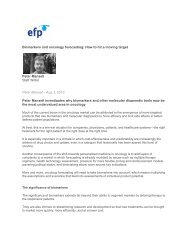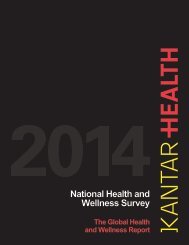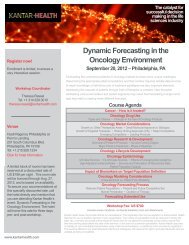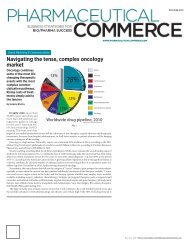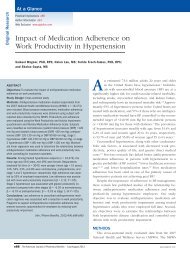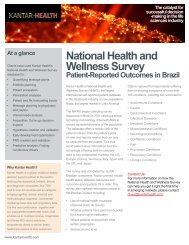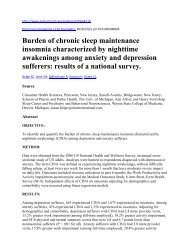Challenges and Caveats in Oncology Forecasting - Kantar Health
Challenges and Caveats in Oncology Forecasting - Kantar Health
Challenges and Caveats in Oncology Forecasting - Kantar Health
You also want an ePaper? Increase the reach of your titles
YUMPU automatically turns print PDFs into web optimized ePapers that Google loves.
Reactions<br />
Correct <strong>in</strong>clusion <strong>and</strong><br />
application of biomarkers<br />
yields a commercial<br />
advantage.<br />
disease, patterns of recurrence, remission,<br />
<strong>and</strong> survival. A major concern is that, once a<br />
patient is treated with a given therapy, they are<br />
not eligible to be treated with the same therapy<br />
aga<strong>in</strong>. In this case, a patient-flow model is<br />
suggested, to avoid count<strong>in</strong>g <strong>in</strong>eligible patients<br />
<strong>in</strong>accurately.<br />
A patient-flow model is also best for diseases<br />
whose progression, survival, <strong>and</strong> treatment<br />
duration is expected to change over time.<br />
It is important to take these factors <strong>in</strong>to<br />
consideration when decid<strong>in</strong>g on a forecast<strong>in</strong>g<br />
approach, <strong>and</strong> to evaluate if additional <strong>in</strong>sight<br />
gleaned from a patient-flow model is worth the<br />
additional time, effort <strong>and</strong> resources, as is often<br />
the case with oncology forecasts. A crosssectional<br />
approach may be possible if one is<br />
focus<strong>in</strong>g on a s<strong>in</strong>gle population/<strong>in</strong>dication.<br />
Question 2: What unique forecast<strong>in</strong>g<br />
considerations are posed by<br />
biomarkers <strong>in</strong> oncology products?<br />
A biomarker is a characteristic that is objectively<br />
measured <strong>and</strong> evaluated as an <strong>in</strong>dicator<br />
of normal biological processes, pathogenic<br />
processes, or pharmacologic responses to a<br />
therapeutic <strong>in</strong>tervention. Currently, biomarkers<br />
are measured <strong>in</strong> one of two ways: on a<br />
cont<strong>in</strong>uum or yield<strong>in</strong>g a “yes” or “no” response.<br />
Biomarkers are becom<strong>in</strong>g more prevalent <strong>in</strong> the<br />
oncology market, <strong>and</strong> can have significant impact<br />
on drug development <strong>and</strong> oncology product<br />
revenue. Many biomarkers have become part<br />
of the st<strong>and</strong>ard of care, <strong>in</strong>clud<strong>in</strong>g therapies for<br />
breast cancer, colon cancer, chronic myeloid<br />
leukemia (CML), non-small cell lung cancer<br />
(NSCLC), melanoma <strong>and</strong> other tumor types.<br />
Biomarkers add complexity to oncology<br />
forecast<strong>in</strong>g s<strong>in</strong>ce populations must be precisely<br />
def<strong>in</strong>ed. In turn, assumptions are derived for<br />
each def<strong>in</strong>ed population, guid<strong>in</strong>g <strong>in</strong>formed<br />
decision mak<strong>in</strong>g to uncover commerciallyviable<br />
opportunities. It is important to consider<br />
that biomarkers may not always correlate <strong>in</strong><br />
conjunction with the cl<strong>in</strong>ical outcome.<br />
Accurate application is also very important. When<br />
applied <strong>in</strong>correctly, eligible patients who could<br />
benefit may be excluded. While many perceive<br />
the benefits of biomarkers to outweigh the<br />
negatives, they may not be necessary <strong>in</strong> all cases<br />
– many drugs have been developed without the<br />
use of companion biomarkers.<br />
Question 3: How do targeted<br />
therapies affect oncology<br />
forecast<strong>in</strong>g?<br />
Treatment methods for oncology vary based<br />
on the tumor type. One approach grow<strong>in</strong>g<br />
<strong>in</strong> popularity is the use of targeted therapies<br />
whether or not there is a correspond<strong>in</strong>g<br />
biomarker. Specifically, small molecule tyros<strong>in</strong>e<br />
k<strong>in</strong>ase <strong>in</strong>hibitors <strong>and</strong> monoclonal antibodies<br />
can be used as s<strong>in</strong>gle agents or <strong>in</strong> comb<strong>in</strong>ation<br />
with cytotoxic drugs or other targeted therapies.<br />
Although they represent the largest area of<br />
commercial growth <strong>and</strong> number of approvals <strong>in</strong><br />
the oncology market, there is still an unmet need<br />
for targeted therapies <strong>in</strong> efforts to reduce drug<br />
toxicity.<br />
Identify<strong>in</strong>g forecast<strong>in</strong>g assumptions is key <strong>in</strong><br />
assess<strong>in</strong>g the commercial potential of oncology<br />
drugs. While duration of therapy is straightforward<br />
<strong>and</strong> well def<strong>in</strong>ed for cytotoxic drugs, for<br />
targeted therapies, it is generally determ<strong>in</strong>ed<br />
by progression of a disease as opposed to a<br />
set time period or number of treatment cycles.<br />
Therapies exceed<strong>in</strong>g one year <strong>in</strong> duration<br />
create added complexity to forecasts as they<br />
necessitate monthly patient breakouts <strong>in</strong> place<br />
of the typical yearly forecasts, to accommodate<br />
every month past the one-year mark for the<br />
duration of the targeted therapy.<br />
www.kantarhealth.com



